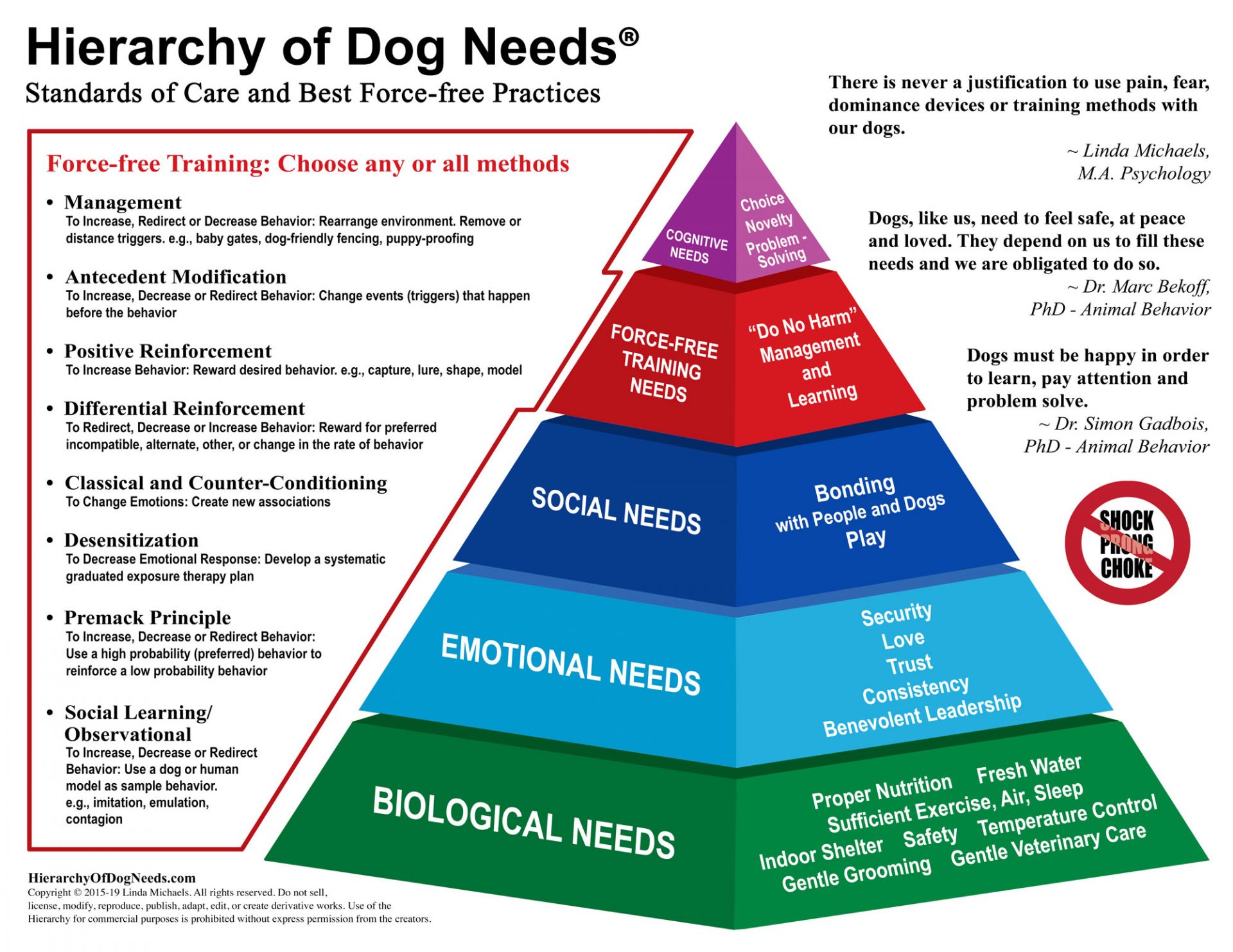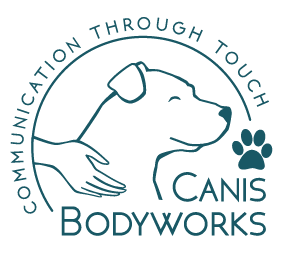
People often ask how canine massage therapy fits into their dog's overall wellness program. Most people understand the benefits of massage for the human body – increased circulation, decreased stress and anxiety, relaxation of tight muscles, smoother movement of joints, and a general sense of well-being. The same benefits of massage apply to the canine body, but the work of canine massage has tentacles that reach farther than these more obvious benefits. In short, massage fits into all aspects of a dog’s wellness needs. But, how?
Readers may be familiar with Abraham Maslow’s classic pyramid-shaped “Hierarchy of Needs.” Maslow's theory states that how we behave is motivated by certain physiological needs. The most basic human needs are represented at the bottom of the pyramid – such as food, water, and shelter – and the more complex needs are toward the top – such as the need for belonging and the need for personal growth. The point of the pyramid is to show that the complex, higher-up-on-the-pyramid needs cannot be obtained if the essential needs toward the bottom of the pyramid have not been met. Without a strong foundation, overall wellness cannot be achieved.
Did you know that there is also a similar “Hierarchy of Needs” specific to dogs? Maslow’s theories were adapted to dogs in 2015 by Linda Michaels (MA; dog trainer; researcher; psychologist; and certified fear, aggression, and reactivity consultant) so that we have a better understanding of what our canine companions need, how we can help them by strengthening their foundation, and how we can better troubleshoot canine behavior challenges when they arise.
On every level of the “Hierarchy of Dog Needs,” we can enhance a dog’s general health and well-being through canine massage.
Biological Needs
Wellness begins with a strong foundation. Without these basics fulfilled, a dog cannot even begin to meet their emotional needs. As canine massage therapists, we often work with dogs who may not have all of their biological needs met. For example, many of our canine clients are older, injured, sick, anxious, fearful, or compromised in some other fundamental way. Guiding pet parents toward respected and effective resources, providers, and home care to meet their dog’s needs is an important part of what we can do.
Likewise, when we work with any dog, we always work first at this foundational level. Our most important job is to ensure that their basic biological needs are being met. If it’s the first time we’re meeting, we’re a stranger to them, and the environment may be new or different, so their sense of safety may be disrupted initially. They may be in pain or discomfort and, as a result, may not be sleeping well or exercising as much as they did in the past. Through our work as certified practitioners, we can use massage and trust-building techniques to address the dog’s individual needs and help fill the voids on this level of the pyramid.
Emotional Needs
Our dogs are emotional creatures, and their psychological health is just as important as their physical health. Once we have helped a dog meet their most basic biological needs, we can continue to work with them on this higher level through our work as massage therapists. Trust-building doesn’t end once a dog feels safer in our presence; we must be consistent and continue to build trust so that the dog allows us to work in areas of their body where they may feel sore or painful and guarded. If a dog trusts us, and trusts that massage won’t be forced onto them if they’re not ready, they will allow us to do our work fully. Just like with any relationship, when mutual respect is formed, the relationship grows, and trust continues to develop.
Social Needs and Force-Free Training
Like humans, dogs are social animals. Dogs need to socialize with other dogs and people to live full, healthy lives. Proper socialization of dogs at an early age, along with positive interactions and touch, are key for the formation of social skills. As massage practitioners, we understand that “social dogs” are also safe dogs. Dogs who are not well socialized, or who lack a social skillset, are usually fearful, anxious, and plagued with behavioral problems. These are the dogs that usually bite or aggress out of fear. We don’t shy away from these dogs or reject them, though, simply because their social needs weren’t met when they were growing. Instead, we work with our canine clients and their families to ensure that proper socialization is provided, and we offer force-free resources for those dogs with no social skills, advanced behavioral challenges, or aggressive tendencies.
Cognitive Needs
When we help a dog meet their foundational needs, they can reach the top of the pyramid, the height of canine wellness. Getting them to this point, though, is a team effort. As canine massage therapists, we play an important role, but it’s the pet parents who are an essential part of their dog’s progress. Together, we enhance quality of life, health, and happiness for our canine companions.
Readers may be familiar with Abraham Maslow’s classic pyramid-shaped “Hierarchy of Needs.” Maslow's theory states that how we behave is motivated by certain physiological needs. The most basic human needs are represented at the bottom of the pyramid – such as food, water, and shelter – and the more complex needs are toward the top – such as the need for belonging and the need for personal growth. The point of the pyramid is to show that the complex, higher-up-on-the-pyramid needs cannot be obtained if the essential needs toward the bottom of the pyramid have not been met. Without a strong foundation, overall wellness cannot be achieved.
Did you know that there is also a similar “Hierarchy of Needs” specific to dogs? Maslow’s theories were adapted to dogs in 2015 by Linda Michaels (MA; dog trainer; researcher; psychologist; and certified fear, aggression, and reactivity consultant) so that we have a better understanding of what our canine companions need, how we can help them by strengthening their foundation, and how we can better troubleshoot canine behavior challenges when they arise.
On every level of the “Hierarchy of Dog Needs,” we can enhance a dog’s general health and well-being through canine massage.
Biological Needs
Wellness begins with a strong foundation. Without these basics fulfilled, a dog cannot even begin to meet their emotional needs. As canine massage therapists, we often work with dogs who may not have all of their biological needs met. For example, many of our canine clients are older, injured, sick, anxious, fearful, or compromised in some other fundamental way. Guiding pet parents toward respected and effective resources, providers, and home care to meet their dog’s needs is an important part of what we can do.
Likewise, when we work with any dog, we always work first at this foundational level. Our most important job is to ensure that their basic biological needs are being met. If it’s the first time we’re meeting, we’re a stranger to them, and the environment may be new or different, so their sense of safety may be disrupted initially. They may be in pain or discomfort and, as a result, may not be sleeping well or exercising as much as they did in the past. Through our work as certified practitioners, we can use massage and trust-building techniques to address the dog’s individual needs and help fill the voids on this level of the pyramid.
Emotional Needs
Our dogs are emotional creatures, and their psychological health is just as important as their physical health. Once we have helped a dog meet their most basic biological needs, we can continue to work with them on this higher level through our work as massage therapists. Trust-building doesn’t end once a dog feels safer in our presence; we must be consistent and continue to build trust so that the dog allows us to work in areas of their body where they may feel sore or painful and guarded. If a dog trusts us, and trusts that massage won’t be forced onto them if they’re not ready, they will allow us to do our work fully. Just like with any relationship, when mutual respect is formed, the relationship grows, and trust continues to develop.
Social Needs and Force-Free Training
Like humans, dogs are social animals. Dogs need to socialize with other dogs and people to live full, healthy lives. Proper socialization of dogs at an early age, along with positive interactions and touch, are key for the formation of social skills. As massage practitioners, we understand that “social dogs” are also safe dogs. Dogs who are not well socialized, or who lack a social skillset, are usually fearful, anxious, and plagued with behavioral problems. These are the dogs that usually bite or aggress out of fear. We don’t shy away from these dogs or reject them, though, simply because their social needs weren’t met when they were growing. Instead, we work with our canine clients and their families to ensure that proper socialization is provided, and we offer force-free resources for those dogs with no social skills, advanced behavioral challenges, or aggressive tendencies.
Cognitive Needs
When we help a dog meet their foundational needs, they can reach the top of the pyramid, the height of canine wellness. Getting them to this point, though, is a team effort. As canine massage therapists, we play an important role, but it’s the pet parents who are an essential part of their dog’s progress. Together, we enhance quality of life, health, and happiness for our canine companions.



